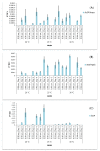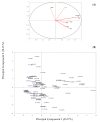Monitoring the Temporal Expression of Genes Involved in Ochratoxin A Production of Aspergillus carbonarius under the Influence of Temperature and Water Activity
- PMID: 28937586
- PMCID: PMC5666343
- DOI: 10.3390/toxins9100296
Monitoring the Temporal Expression of Genes Involved in Ochratoxin A Production of Aspergillus carbonarius under the Influence of Temperature and Water Activity
Abstract
The objective of this study was to investigate the effect of environmental factors, namely temperature and water activity, on genes involved in the regulation of ochratoxin A (OTA) production over time. For this purpose, the previously characterized toxigenic Aspergilluscarbonarius Ac29 isolate from Greek vineyards and the A. carbonarius ITEM 5010 reference strain were subjected to combined temperature and water activity (aw) treatments to study OTA production and relative gene expression. The fungal isolates were grown on a synthetic grape juice liquid medium (SGM) under different temperature (20 °C, 25 °C and 30 °C) and aw (0.94 and 0.98) regimes. The expression of the AcOTApks, AcOTAnrps, and laeA OTA related genes was investigated using real time PCR. Gene expression was monitored at the same time points, along with fungal biomass and OTA accumulation at three, six and nine days of incubation. In gene expression analysis, stimulation of the biosynthetic genes was observed a few days before any toxin could be detected. This fact may underline a possible early indicator of potential toxin contamination of grapes. However, the transcript levels varied with respect to the different combinations of ecophysiological conditions and time, highlighting a complex regulation of OTA related gene expression of A. carbonarius in the specific medium.
Keywords: Aspergillus carbonarius; OTA; SGM; biosynthetic genes; temperature; water activity.
Conflict of interest statement
The authors declare no conflicts of interest.
Figures





References
-
- World Health Organization (WHO) Selected Mycotoxins: Ochratoxins, Trichothecenes, Ergot. Environ. Health Criteria. 1990;105:1–260.
-
- Gallo A., Bruno K.S., Solfrizzo M., Perrone G., Mule G., Visconti A., Baker S.E. New insight into the ochratoxin A biosynthetic pathway through deletion of a nonribosomal peptide synthetase gene in Aspergillus carbonarius. Appl. Environ. Microbiol. 2012;77:8208–8218. doi: 10.1128/AEM.02508-12. - DOI - PMC - PubMed
Publication types
MeSH terms
Substances
LinkOut - more resources
Full Text Sources
Other Literature Sources

